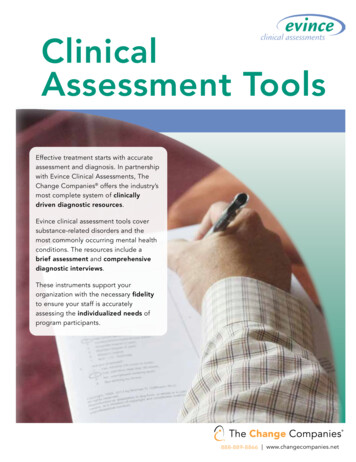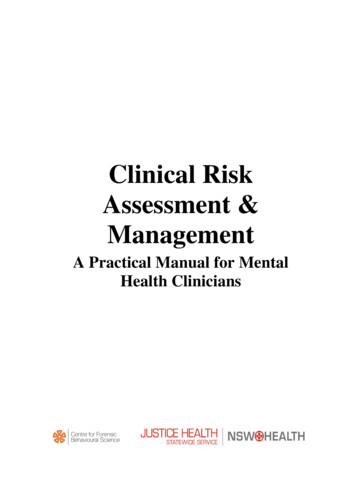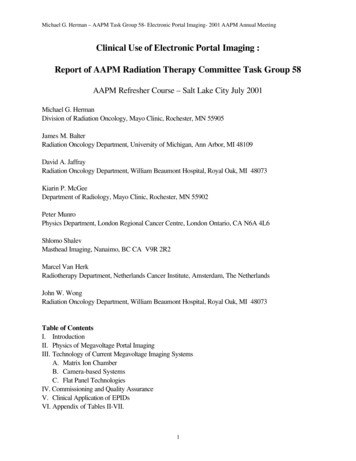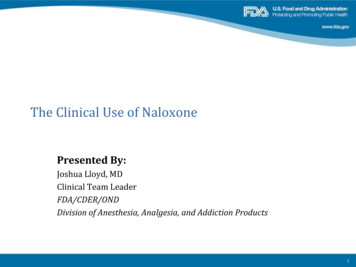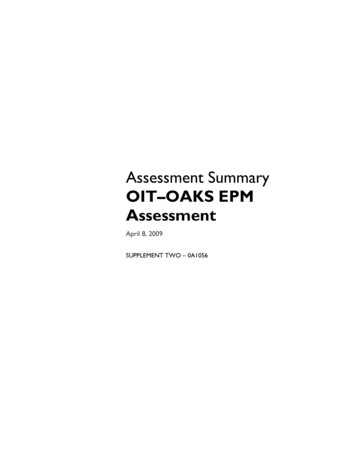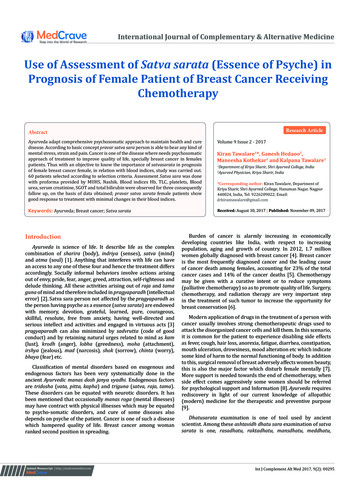
Transcription
ARC Journal of Nursing and HealthcareVolume 5, Issue 1, 2019, PP 1-8ISSN No. (Online) 2455-4324DOI: cjournals.orgAssessment of Use in Clinical Practice of Internal MedicineNursing Practice Student Training ModuleNuray Enç1, Havva Alkan2, Hilal Uysal2*, Gülbeyaz Can1, Zeliha Tülek3Professor, PhD, RN, Istanbul Universitesi-Cerrahpaşa Florence Nightingale Faculty of Nursing, InternalMedicine Nursing Department123Assistant professor, PhD, RN, Istanbul Universitesi-Cerrahpaşa Florence Nightingale Faculty of Nursing,Internal Medicine Nursing DepartmentAssociate Professor, PhD, RN, Istanbul Universitesi-Cerrahpaşa Florence Nightingale Faculty of Nursing,Internal Medicine Nursing Department*Corresponding Author: Hilal Uysal, Istanbul Universitesi-Cerrahpaşa Florence NightingaleFaculty of Nursing Abide-i Hurriyet Cd. 34387 Sisli /Istanbul/ Turkey. Email: hilaluysal@gmail.comAbstractIntroduction & Purpose: During internal medicine nursing practice, student nurses need a diagnostic toolto guide comprehensively determine their care needs of patients with different health problems. The purposeof this study, which contributes to practice education in internal medicine nursing, to evaluate usability ofInternal Medicine Nursing Practice Student Training Module which based on the model of Gordon’sfunctional health patterns by students.Methods: Research, at a state university's nursing faculty, 2014-2017 academic years, Internal MedicineNursing course who agreed to participate in the study with 877 second grade students were performed. Datawere collected by questionnaire containing of 10 questions related to the use of student training module.Frequency distribution was used the evaluating of the data.Results: Of the students who participated in the research, 84.6% were female, 15.4% were male and themean age was 20.01 1.413. The majority of students were undecided about the benefit of using the modulein clinical practice. However, he found that those who thought it useful were more than those who thought itwas not useful. In the study, it was determined that female students performed better patient diagnosis,diagnosed criteria and diagnosis, case analysis than males.Discussion and Conclusion: The goal of health care services is to provide quality care. As a health careworker, it is imperative that nurses use the nursing models and theories to plan patient care in a plannedmanner based on scientific principles. In this study, it is generally concluded that Internal Medicine NursingPractice Student Training Module is useful for patient diagnosis, diagnosis criteria and nursing diagnosis.Keywords: Students, nursing, internal medicine, education.1. INTRODUCTIONNew requirements and demands in the field ofhealth,scientificinformationcontent,developments in medical science andtechnology affect nursing (Güner & Terakye,2000). Modern nursing adopts a systematicapproach to organizing and maintaining care,with the modern roles it undertakes, to enablethe individual to receive the best nursing care.This approach is the nursing process. Thenursing process is a method used to presentindividualized care in determining andeliminating problems (Keski & Karadağ, 2010).The implementation of the nursing processfacilitates the effective use of time and laborARC Journal of Nursing and Healthcareforce for the purpose, as it provides theopportunity to determine priorities in the care tobe given (Karadakovan, 2004).However, it is necessary to use the nursingprocess together with a nursing model in orderto achieve a systematic and evidence-basedscientific approach. The care given in this waywill be appropriate to meet the individual'sneeds (Kaya, Babadağ, Yeşiltepe Kaçar &Uygur, 2010). In 1987, Marjory Gordondeveloped a leri Functional Health Pattern(SRS) Model “that addresses individuals in acomprehensive bio-psycho-social dimension andexplains the care needs of individuals in 11functional areas. Eleven areas in the model,Page 1
Assessment of Use in Clinical Practice of Internal Medicine Nursing Practice Student Training Modulesystematic and standardized informationcollection approach and nursing perspectiveprovides information to analyze. Gordon's FSSenables nurses to perform an individualizedcomprehensive assessment of patient care and toapply the nursing process (Erdemir & Yılmaz,2005).Internal Medicine Nursing lesson is a secondyear lesson. Students begin to learn thetheoretical knowledge and application skills ofdiseases in this period. Therefore, because thetheoretical and practical skills of the students arenot sufficient in clinical practice, patientevaluations are insufficient. Gordon's FSÖmodel allows students to analyze the individualfrom a bio-psycho-social perspective in order tocollect systematic and standardized informationfrom a nursing perspective. Students will beable to collect data more quickly after they haveunderstood this systematic and prioritize themand plan and implement the necessary initiativesto solve the problems identified. Therefore,based on Gordon's Functional Health PatternsModel, Internal Medicine Nursing PracticeStudent Training Module was created (Enç,Can, Özcan, Tülek, Uysal & Alkan, 2012).Functional health patterns are a model that canbe used to assess human / human reactions inyoung or old, female or male, all areas and atany health level, in acute / chronic conditionsand in any medical diagnosis (Erdemir &Yılmaz, 2005).In the internal medicine nursing lesson, in 2012,we used the Internal Medicine Nursing PracticeStudent Training Module in clinical practice. Byusing the module in practice, it is aimed that thestudents diagnose the patient, identify theproblems and plan the attempts for theproblems, make the system of application andevaluation in a systematic way and develop theircritical thinking skills.2. METHODSDesign and Sample: This study was plannedand implemented as a descriptive study in orderto evaluate the use of the Internal MedicineNursing Practice Student Training Module. Theresearch was conducted in the nursing faculty ofa public university in 2014-2016 in twoacademic years. The study was carried out as adescriptive study with 877 second gradestudents who were trained in the clinicalpractice of Internal Medicine Nursing courseand accepted to participate in the research.There were no students who refused toARC Journal of Nursing and Healthcareparticipate in the study at the specified dates andthe whole universe was reached.Research Questions1. Students think which steps of the InternalMedicine Nursing Practice Student TrainingModule are useful?2. Are there any differences according tosociodemographiccharacteristicsofstudents in their thoughts about theusefulness of the use of the module inclinical practice?Data CollectionThe questionnaire used in the study wasprepared by the researchers in order to evaluatethe thoughts of the module on the use of clinicalpractice by the students in the scope of internalmedicine nursing practice student trainingmodule. The questionnaire includes questionsabout the individual characteristics of thestudents such as age, gender, high school,graduation status, health insurance, incomelevel. There are 10 questions about theusefulness of the module while performing thenursing process during the clinical practice ofinternal medicine nursing. There is also aquestion in the questionnaire where students askfor additional ideas and suggestions regardingthe use of the module.Data AnalysisAll analyzes were performed on computer inİ.Ü. Statistical Package for Social Sciences(SPSS) was performed using 21 packageprograms. In the evaluation of parametricvariables, arithmetic mean, standard deviation,frequency and percentage tests were used toevaluate nonparametric variables. The value ofsignificance was accepted as p 0.05.Ethical IssuesParticipation in the study was based on avoluntary basis. Informed consent was obtainedfrom the students who accepted to participateafter the necessary explanations and thequestionnaires were given to the students. Allexpenses of the research were covered by theresearchers.3. RESULTSIn this study, 84.6% of the students were female,15.4% were male and the mean age was20.01 1.413. The majority of the students(93.7%) were graduated from Anatolian-ScienceHigh School and only eigtht students weregraduated from health vocational high school(Table 1).Page 2
Assessment of Use in Clinical Practice of Internal Medicine Nursing Practice Student Training ModuleTable1. Socio-Demographic Characteristics (N 877)N (%)20.01 1.413Age (Mean SD)GenderFemaleMaleEducation StatusHigh SchoolHealth Vocational High SchoolOther Vocational High SchoolInternship Made SectionIstanbul University Istanbul Faculty of MedicineIstanbul University-Cerrahpaşa Cerrahpaşa Faculty ofMedicineIstanbul University-Cerrahpaşa Cardiology InstituteWork StatusYesNoEconomical SituationBadGoodSocial SecurityYesNoThe majority of the students were undecidedabout the usefulness of the Internal MedicineNursing Practice Student Training (91.7)790(90.1)87(9.9)However, it was found that those who think thatit is beneficial are more than those who think itis not useful (Table 2).Table2. Students' thoughts about the benefit of using in the clinical practice of the Internal Medicine NursingPractice Student Training Module (N 877)Patient diagnosisDeterminingdiagnosticcriteria(signs and symptoms)Interpretdiagnosticcriteria (signs andfindings)Determiningthediagnosis of nursingDetermining the causeof the problemObjective / goal ng reportCase analysisNot useful at all Not a little useful Undecided A little usefulN (%)N (%)N (%)N )319(36.4)319(42.8)Very helpfulN .8)237(27.0)243(27.7963(7.2)56(6.4972(8.2)In the research, it was determined that womenhad better patient diagnosis, determined thediagnostic criteria and diagnosis, and had theability to perform case analysis. However, it wasfound that the ability of men to interpret thediagnostic criteria, to determine the cause,purpose / goal, to create the interventions, toevaluate and to report was better than that ofwomen (Table 3). In this study, it wasdetermined that nursing students who areARC Journal of Nursing and Healthcaregraduates of health vocational high schoolscould apply their nursing process skills to abetter level by using the Student TrainingModule (Table 3). In the study, the ability of thestudents who did not work in any job to performthe nursing process steps by using the modulewas found to be higher than the students whowere working and they were found to benefitmore than using the module (Table 3).Page 3
Assessment of Use in Clinical Practice of Internal Medicine Nursing Practice Student Training ModuleTable3. Evaluation of the usefulness of the using of the the Internal Medicine Nursing Practice StudentTraining Module in clinical practice according to sociodemographic characteristics (N 877)Objective/DeterminingInterpret osticdiagnostic diagnostic the diagnosisthe cause iacriteria of nursing the probleminterventionsGenderFemale3.45 0.83(N 742)Male (N 135) 3.33 0.97EducationStatus3.43 .85HighSchool(N 822)Health4.13 .99VocationalHigh School(N 8)3.38 .76OtherVocationalHigh School(N 47)Work StatusYes (N 35)3.51 .85No (N 842) 3.51 .98EconomicalSituationBad (N 73)3.33 .97Good (N 804) 3.44 .843.46 0.82 3.28 0.83 3.58 0.843.19 0.793.24 0.813.29 .883.19 .86 3.14 .86 3.22 .903.44 0.92 3.39 0.93 3.53 1.023.22 0.883.33 0.933.36 .983.30 .94 3.23 .99 3.16 .963.45 .833.30 .853.57 .873.20 .803.26 .823.29 .893.20 .86 3.15 .87 3.21 .903.88 .643.88 .64 3.75 1.033.38 1.063.88 .833.38 1.063.88 .99 3.38 1.063.50 1.193.55 .853.26 .793.57 .923.15 .883.15 1.023.40 1.013.17 .94 3.13 .96 3.11 1.003.51 .833.51 .953.40 .85 3.60 .873.40 .91 3.60 1.003.17 .803.17 .783.37 .833.37 .943.40 .893.40 1.063.29 .98 3.29 .92 3.11 .933.20 .86 3.15 .88 3.21 .913.38 .92 3.25 .94 3.36 .993.08 .98 3.14 .94 3.25 1.03 3.23 .96 3.12 .95 3.15 1.023.46 .82 3.30 .843.59 .863.21 .78 3.27 .823.30 .88 3.21 .86 3.16 .87 3.22 .90The results of our study showed that thestudents with the income level had betterbenefits than the ones using the module (Table3). In this study, According to the gender theviews of the use of modules to implementnursing process steps are examined; In bothsexes, it was determined that the use of themodule was in the majority of students a littleuseful tool for diagnosing (χ2 13.43 p 0.009),and determining the nursing diagnosis (χ2 10.74p 0.03). However, to determine the diagnosticcriteria (χ2 5.63 p 0.22), to interpret thediagnostic criteria (χ2 6.24 p 0.18), todetermine the cause of the problem (χ2 4.98p 0.28), to determine the purpose and target(χ2 8.28 p 0.08) to establish nursinginterventions (χ2 6.81 p 0.14), to makeevaluation (χ2 4.99 p 0.28), to establish nursingreport (χ2 17.20 p 0.002) and to perform caseanalysis (χ2 1.77 p 0.77) it was found that theywere undecided about the usefull of using of themodule (Table 3).Thoughts and Suggestions of the Students onthe Use of the ModuleThey stated that the module was useful butcould not get enough benefit because theduration of clinical practice was limited. TheARC Journal of Nursing and Healthcarestudents stated that the contents of the modulewere intensive according to the time spent withthe patient. It was stated that the moduleprovided benefit to the student in order to createa ca
based on Gordon's Functional Health Patterns Model, Internal Medicine Nursing Practice Student Training Module was created (Enç, Can, Özcan, Tülek, Uysal & Alkan, 2012). Functional health patterns are a model that can be used to assess human / human reactions in young or old, female or male, all areas and at any health level, in acute / chronic conditions and in any medical diagnosis .





